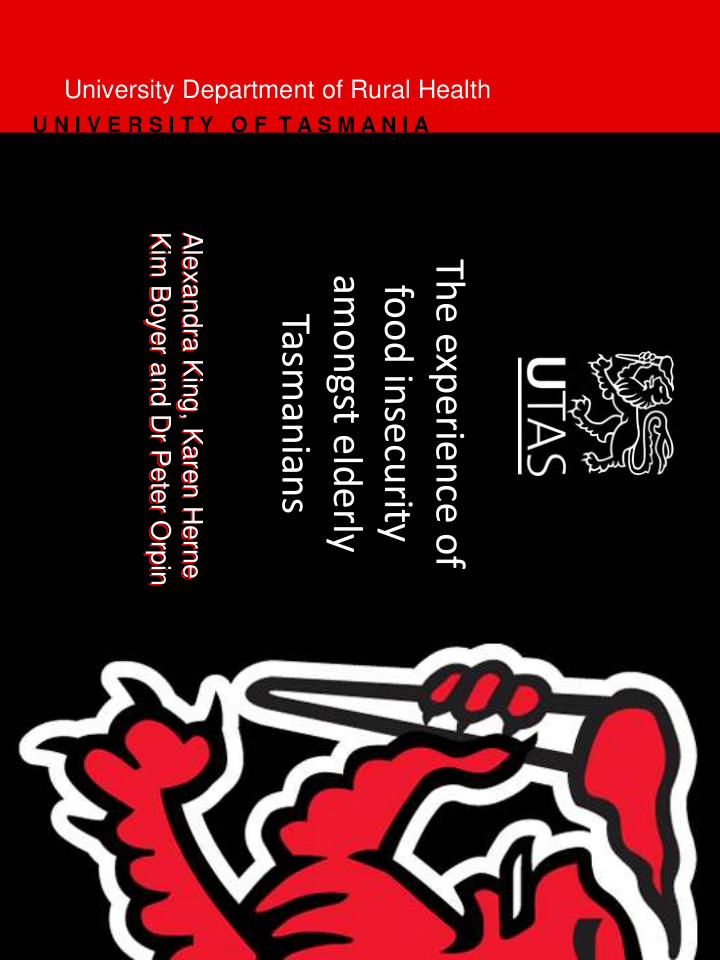



University Department of Rural Health University Department of Rural Health U N I V E R S I T Y O F T A S M A N I A Kim Boyer and Dr Peter Orpin Alexandra King, Karen Herne The experience of amongst elderly food insecurity Tasmanians
UTAS Healthy Eating for Healthy Ageing Research Three projects • Tasmanian Government funded meals services for older people – strengths and weaknesses • Case study – Social eating opportunities for older people in a rural Tasmanian community • Review – Models and programs to support social eating interventions for older people. An overview of these projects and the key findings were presented by Ms Kim Boyer at the PHAA 1 st Food Futures Conference 2010 – in her presentation “Never Mind the Food – It’s the company that matters”. www.utas.edu.au/ruralhealth 2
UTAS Healthy Eating for Healthy Ageing Research Key Findings • The social dimensions of meal services were more important to older people than the nutritional content or the quality of the meals provided. • Current food service models in Tasmania do not necessarily reflect the diverse range of food and eating preferences amongst older people. • There was a very low level of recognition of nutritional risk and malnutrition among older rural people in the community and amongst service providers. www.utas.edu.au/ruralhealth 3
Defining food security Food security is: “… access by all people at all times to enough food for an active, healthy life. Food security includes at a minimum: a) the ready availability of nutritionally adequate and safe foods, and b) an assured ability to acquire acceptable foods in socially acceptable ways (e.g. without resorting to emergency food supplies, scavenging, stealing or other coping strategies )”. 1 Food insecurity is: “whenever the availability of nutritionally adequate and safe foods or the ability to acquire acceptable foods in socially acceptable ways is limited or uncertain ”. 1 1. Anderson, S. A. 1990. Core indicators for nutritional state for difficult-to-sample populations. Journal of Nutrition, 120 , 1559- 1599. 4
Why focus on older adults? Older adults are a growing group: Older adults tend to live at home: In 2006: • 94% of 65 years + lived in private dwellings • 29% of 65 years + lived alone in private dwellings • 39% of 85 years + lived alone in private dwellings. Older adults are living longer: Born in 2010: 80.1 years Born in 2010: 84.4 years Born in 2050: 87.7 years Born in 2050: 90.5 years 5
How does food insecurity affect older adults? Malnutrition or sub-optimal nutrition Low BMI or obesity Depressive symptoms Poorer management of diabetes Diminished immunity Poorer self-reported health More frequent admission to hospital Earlier admission to residential care Higher morbidity Higher health care Lower quality of life Earlier death and aged care costs 6
Australian research • Very limited Australian research on food insecurity in older people. • Income question used in all government surveys: – “In the last 12 months, were there any times that you ran out of food and couldn’t afford to buy more?” • Prevalence: General population: 5% Older adults: 2% • Food insecurity in older Australians is most likely under- reported. 7
Non-economic factors International studies have identified the following as contributing to food insecurity in older adults: • Poor health • Limited mobility • Lack of social support • Past life experiences • Perceptions of food security • Availability of preferred food
Key points • Food security in older people is a complex issue • Current single question measures do not capture that complexity • Very limited Australian research – mostly quantitative • A need for in-depth qualitative research
PhD Research, June 2011 – June 2014 “Household Food Security A mongst Older Adults in Rural Tasmania”: Preliminary Progress Aim: To investigate the nature and context of food insecurity amongst older adults living in rural Tasmania to inform a more thorough and complex conceptualisation of food insecurity for older adults. Qualitative approach: • To elicit rich and detailed data from older adults of their experiences of food insecurity in rural Tasmania. • People are assumed to be experts on their own lives: “knowledgeable narratives of people in places” (Williams 2003). www.utas.edu.au/ruralhealth 10
PhD Research, June 2011 – June 2014 “Household Food Security A mongst Older Adults in Rural Tasmania”: Preliminary Progress Methodological framework: • Case study approach. • Also investigating phenomenology. Proposed methods: • In-depth semi-structured interviews with a small sample of older adults living in rural Tasmania – more than one interview. • Brief supplementary interviews with family members or friends of participants. • Possible use of a nutrition or food security screening tool – currently investigating tools. www.utas.edu.au/ruralhealth 11
PhD Research, June 2011 – June 2014 Proposed Research Questions What is the nature and context of the experience of food insecurity amongst older adults living in rural Tasmania? a. What are the social dimensions of food insecurity in older adults? How do these factors change over time? b. How does place inform food insecurity in older adults? www.utas.edu.au/ruralhealth 12
Contacts • Alexandra.King@utas.edu.au • Karen.Herne@utas.edu.au • Kim.Boyer@utas.edu.au • Peter.Orpin@utas.edu.au www.utas.edu.au/ruralhealth 13
Recommend
More recommend